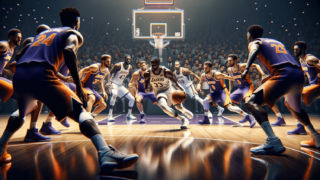
In the diverse and exciting world of basketball, the ‘Pass and Cut’ is an essential offensive maneuver designed to create scoring opportunities for your team. If you’ve been scratching your head wondering precisely how this technique works, or you’re eager to learn the many intricacies that bring it to life, you’re in the right place. In today’s blog post, we’ll dive headfirst into the world of the Pass and Cut, exploring its ins and outs while providing practical insights that’ll help you elevate your basketball game. So, buckle up and get ready to take your basketball knowledge to new heights with our fun and professional guide to mastering the art of the Pass and Cut.
What’s a Pass and Cut in Basketball?
A Pass and Cut in basketball is an offensive strategy where a player passes the ball to a teammate and then makes a quick cut towards the basket. The goal of this move is to create space for the passer and exploit the defense’s momentary lapses in concentration or miscommunication, potentially leading to an easy scoring opportunity. The Pass and Cut can be performed on the perimeter, in transition, or during half-court sets, highlighting its versatility as an essential component of any well-rounded offensive playbook.
Understanding the Basics of Pass and Cut
Before we delve into the nitty-gritty of the Pass and Cut, it’s essential to grasp the basics. In basketball, learning to effectively move without the ball is just as crucial as mastering dribbling, shooting, or passing. The Pass and Cut technique encapsulates this skill, as it involves both the passer and the cutter working in tandem to make the play successful. Being able to seamlessly execute a Pass and Cut can vastly improve a team’s offensive prowess and keep defenders on their toes.
The Anatomy of a Pass and Cut
To truly appreciate the Pass and Cut, let’s break it down step by step:
1. The Preparatory Position
Before initiating the Pass and Cut, players should be keenly aware of their surroundings and the positioning of teammates and opponents. Proper spacing is vital, as it allows the play to unfold without congestion, and maximizes the chances of an open passing lane or a clean cut to the rim.
2. The Pass
Once the ideal spacing is established, the player with the ball initiates the Pass and Cut by delivering a crisp, accurate pass to their teammate. It’s crucial to note that the basketball should be passed to the intended target and not where the cutter presently is. The ideal pass places the ball slightly ahead, allowing the cutter to catch it in stride while racing towards the basket.
3. The Cut
Immediately after the pass, the passer sharply cuts towards the basket, looking to exploit any defensive lapses. Quality cuts are concise, purposeful, and aggressive, forcing the defender to make a decision. In essence, the goal is to either receive a return pass for an easy score or draw the defense to create open shots for teammates.
4. Read and React
As the cutter approaches the rim, both the cutter and the passer need to read the defense and make quick decisions. The passer should carefully observe the defender’s positioning and decide whether to return the pass or look for another option. Meanwhile, the cutter should adjust their movement according to the defense, either continuing to the rim, popping out to the perimeter, or pivoting to a secondary move.
Mastering Different Types of Pass and Cut
The Pass and Cut isn’t a one-size-fits-all maneuver; it can be adapted depending on the personnel, offensive scheme, or game situation. Let’s explore several distinct variations for a more nuanced understanding of this versatile move.
1. Wing Pass and Cut
The Wing Pass and Cut is initiated when the ball-handler passes to a teammate positioned on the wing or the three-point line. Once the pass is made, the passer cuts hard towards the basket, aiming to split the defenders’ focus. This move is particularly effective when the ball-handler’s defender sinks too deep in anticipation of a screen or becomes preoccupied with other movements off the ball.
2. Post Pass and Cut
In this variation, the ball-handler delivers a pass to a teammate posting up near the basket. As the pass is made, the passer cuts purposefully towards the hoop, looking to receive a return pass for a high-percentage shot. The Post Pass and Cut is especially effective when executed by smaller, quicker players darting past larger, slower defenders.
3. Dribble Handoff and Cut
This variation adds an additional element to the Pass and Cut: a dribble handoff. The ball-handler dribbles towards their teammate, hands off the basketball, and then cuts hard to the basket. Defenders can be caught off guard by the sudden change of possession, allowing the cutter to exploit any resulting confusion.
Essential Techniques in the Pass and Cut
Although the Pass and Cut may appear simple on the surface, nuanced techniques can mean the difference between success and failure. Let’s examine some key details that will help breathe life into this basketball strategy.
1. Timing
Timing is everything when it comes to the Pass and Cut. The passer and the cutter must synchronize their movements, ensuring the passer doesn’t begin their cut too early or too late. A well-timed cut is fast and decisive, placing pressure on the defense and constraining their options.
2. The Change of Pace
To best deceive the defense, the player initiating the Pass and Cut should vary their speed. By briefly hesitating before initiating the move, they can disrupt the defensive rhythm, lulling the opponent into a false sense of security before rapidly accelerating with the pass and cut.
3. The Art of Deception
Trickery can be an essential ingredient in the Pass and Cut, particularly when disguising intentions. Use your eyes to deceive your defender, looking in one direction while gearing up to pass and cut in another. Similarly, a subtle shoulder fake or head nod can provide just enough misdirection to leave your defender in the dust.
4. Quick Decision-Making
Quick, decisive decision-making can make all the difference in the Pass and Cut. Recognizing the rapidly changing game situation, the passer and cutter need to be one step ahead of the defense. Trusting your instincts and making snap decisions can keep the defense on its heels, amplifying the chances of a successful play.
Building Chemistry through Pass and Cut Drills
Mastering the Pass and Cut takes practice and repetition, especially concerning building on-court chemistry between teammates. Through consistent training, players can learn the subtleties of each other’s movements and preferences while instilling the Pass and Cut technique more naturally within the rhythm of their game. The following drills can prove invaluable for developing the art of the Pass and Cut on your basketball team:
1. The Three-Man Weave Drill
This classic basketball drill involves three players continuously passing and cutting across the length of the court. The Three-Man Weave Drill can help build teamwork and foster familiarity in the Pass and Cut process, as players must react and adapt to the movements of their teammates.
2. Four Corners Drill
The Four Corners Drill engages four players simultaneously, two on offense and two on defense. The offense works on their Pass and Cut, while the defense endeavors to contain and defend the play. The addition of defenders to the mix encourages the offense to develop their reading and decision-making skills under pressure.
3. Give-and-Go Drill
The Give-and-Go Drill is a straightforward exercise aimed at reinforcing the basic components of the Pass and Cut. One player initiates the Pass and Cut, while the other returns the pass. Engaging in Give-and-Go Drills can help players improve their timing, precision, and overall understanding of the tactic.
Common Mistakes and How to Avoid Them
As with any basketball technique, pitfalls and errors can plague the Pass and Cut. To maximize this move’s efficiency, be mindful of the common mistakes and how to overcome them:
1. Poor Spacing
As mentioned earlier, proper spacing is crucial to the success of the Pass and Cut. Players must maintain appropriate distance from their teammates, ensuring that passing lanes remain open and defenders cannot easily switch or recover. Keep a conscious eye on your positioning on the court and make adjustments as needed.
2. Lazy Cutting
Making a weak or lazy cut can quickly render the Pass and Cut ineffective. The cutter must maintain purpose and energy in their movement, forcing the defense to react. Stay focused and committed to every cut; you never know when it might lead to a game-changing opportunity.
3. Telegraphing the Pass
Avoid telegraphing your pass, as attentive defenders can easily anticipate and intercept your play. Maintain eye contact with your target, and only break eye contact once the cut has begun. Know when to use bounce passes, chest passes, or lob passes, depending on the situation and the positioning of teammates and opponents.
4. Neglecting the Fundamentals
Many teams and players make the mistake of skimming over the fundamentals when learning or executing the Pass and Cut technique. Revisit the basics frequently and ensure consistent practice to maintain the sharpness of your skills.
By studying, practicing, and refining the Pass and Cut basketball tactic, players can unlock new scoring opportunities and create chaos for opposing defenses. Now that you’re armed with a wealth of knowledge on the subject, it’s time to hit the court and make the Pass and Cut a seamless part of your offensive arsenal.
Defensive Strategies Against the Pass and Cut
In addition to understanding the intricacies of executing the Pass and Cut, players should also be mindful of how opponents defend against this tactic. Recognizing defensive schemes can help the offense adapt and create countermeasures to neutralize their opponents. Let’s explore some common defensive strategies and how to counter them:
1. Switching Defenders
One tactic defenses may use to counter the Pass and Cut is switching defenders, whereby the player initially guarding the cutter switches to guard the passer—often called a ‘switch’ in basketball terminology. In response to this switch, the offense can adjust their approach by taking advantage of any mismatches created, such as posting up smaller defenders or driving past bigger, slower opponents.
2. Denying Passing Lanes
Defenses will often attempt to deny the passing lanes by positioning themselves between the intended passer and cutter. In this case, the offense can adjust by setting backdoor screens, reversing the ball to the opposite side of the court or using dribble penetration to collapse the defense and create alternate scoring opportunities.
3. Help Defense
A proactive help-side defense can provide additional support to defend against the Pass and Cut. The offensive players can exploit gaps in the help defense by relocating or setting screens, forcing defenders to scramble or make split-second decisions, potentially leading to more scoring chances.
Integrating the Pass and Cut into Offensive Systems
While the Pass and Cut is an adaptable and versatile offensive strategy in its own right, it can also be used as a foundation for more intricate offensive systems. Many popular offenses utilize elements of the Pass and Cut to set up more specialized plays:
1. Motion Offense
Many motion offenses are built on the foundation of the Pass and Cut. This approach emphasizes continuous ball movement, player movement without the ball, and constant screening, cutting, and passing actions. Motion offenses capitalize on the defense’s missteps and breakdowns, creating opportunities for open shots and easy points.
2. Princeton Offense
The Princeton Offense is another system that utilizes the Pass and Cut technique. It emphasizes precise cutting, passing, and reading of the defense to create scoring opportunities. This offense typically highlights high basketball IQ and unselfish play, as players are required to make quick decisions and be aware of their teammates’ positions on the court.
3. Triangle Offense
Although the Triangle Offense heavily relies on post play and strategic spacing, it still incorporates elements of the Pass and Cut. Designed to exploit defensive weaknesses, the Triangle Offense emphasizes ball movement and off-ball movement with a focus on cutting and passing to set up various options for shots or high-percentage looks at the basket.
By integrating the Pass and Cut into these more specialized offensive systems or tailoring it to suit a team’s specific skills, players and coaches alike can unlock unique and effective strategies to maintain a potent attack in the game of basketball.
Frequently Asked Questions
When delving into the Pass and Cut in basketball, it’s natural for questions to arise on various aspects of this versatile offensive maneuver. To help address these common queries, we have compiled a list of frequently asked questions and concise answers to enhance your understanding and application of the Pass and Cut technique.
1. Where can I apply the Pass and Cut on the court?
The Pass and Cut can be executed from various positions on the court, including the perimeter, post, or during transition. Its versatility makes it an invaluable part of any offensive playbook.
2. How does the Pass and Cut help create scoring opportunities?
The Pass and Cut helps create scoring opportunities by forcing defenders to make quick decisions, opening passing lanes, and exploiting lapses in defensive coverage. Additionally, it encourages player movement and ball movement, which makes the offense more challenging to defend.
3. Can the Pass and Cut be used with other offensive systems?
Yes, the Pass and Cut can be integrated into various offensive systems, such as the Motion Offense, Princeton Offense, and Triangle Offense. The technique’s adaptability adds to its effectiveness and allows teams to tailor it based on their strengths and preferences.
4. How does defensive switching affect the Pass and Cut?
Defensive switching can impact the Pass and Cut by assigning different defenders to the passer and cutter. Offenses can counter switching by exploiting mismatches or by incorporating screens and ball reversals to disrupt the defense.
5. What drills can I use to practice the Pass and Cut with my team?
Practice drills include the Three-Man Weave Drill, Four Corners Drill, and Give-and-Go Drill. These exercises help develop teamwork, on-court chemistry, and reinforce the basic components of the Pass and Cut technique.
6. What are some common mistakes to avoid when executing the Pass and Cut?
Common mistakes include poor spacing, lazy cutting, telegraphing the pass, and neglecting fundamentals. Avoiding these pitfalls can lead to more successful Pass and Cut plays in games.
7. Can the Pass and Cut be used in zone defenses?
Yes, the Pass and Cut can be used effectively against zone defenses. By focusing on attacking gaps in coverage, creating mismatches, and disrupting the defensive structure, teams can find scoring opportunities within the zone.
8. How does the Pass and Cut help develop players’ individual skills?
The Pass and Cut helps players develop essential individual skills such as timing, decision-making, deception, precision passing, and cutting. These skills are valuable in various aspects of the game, making the Pass and Cut an effective tool for player development.
9. Can I use the Pass and Cut if I’m not a great shooter?
Absolutely! The Pass and Cut emphasizes movement and creating high-percentage shots near the basket, making it perfect for players of all skill levels, including non-shooters.
10. How do I know when to make a cut or pop out to the perimeter?
Reading the defense and anticipating their movements is crucial. If defenders collapse towards the basket, it might be best to pop out to the perimeter. Conversely, if defenders overcommit or fall asleep, cutting to the basket could be the better option.
11. How do spacing and positioning impact the Pass and Cut?
Proper spacing and positioning are vital for successful Pass and Cut execution to keep passing lanes open and avoid congestion. Maintaining an appropriate distance from teammates also makes it more difficult for defenders to switch or recover effectively.
12. How important is communication in the Pass and Cut?
Communication is crucial in the Pass and Cut, as it helps teammates stay aware of each other’s movements and intentions on the court. Effective communication can enhance timing, decision-making, and overall flow, leading to better-executed plays.
13. How can I build on-court chemistry using the Pass and Cut?
Practicing the Pass and Cut consistently with teammates helps develop on-court chemistry by familiarizing players with each other’s tendencies and preferences. Having a strong understanding of how teammates move, cut, and pass creates a more fluid and synergetic offense.
Featured Posts
- No pillar pages found.





